If you are even tangentially aware of the animation discourse that is debated/fought tooth and nail on twitter on a nearly hourly basis, I am firstly sorry for your misfortune but am also confident you have heard the nefarious portmanteau of “CALARTS STYLE.” Levied exclusively against new television animation premiering on Cartoon Network, using CALARTS as a critique became a ubiquitous shorthand for bemoaning the perceived unoriginal and uninspired aesthetics of new animation, essentially accusing the industry of making all cartoons looks alike nowadays. CALARTS is an invented term by animation fans attempting to affix a label to the style of the current era, but has no doctrine, guidelines or proponents and is very much a nebulous critique with no agreed upon definition beyond the examples we ill-advisedly label it because of that lack of a definition. The recent online shitstorm that was the announcement of Thundercats Roar (http://www.slashfilm.com/thundercats-roar/) ignited a whole new debate and reevaluation of the pseudo-term, as well as igniting the fury of a lot of older men towards a kids show that is explicitly not for kids but that (thankfully) is besides the point.
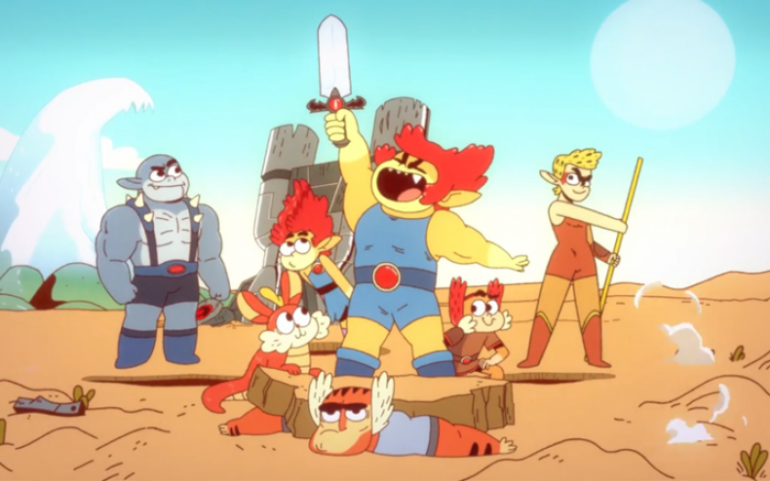
Seeing CalArts thrown around so liberally and with so many irrationally strong emotions attached to every tweet, thread and rant video this announcement spawned got me wondering if we actually have an agreement on what CalArts even is? What it means, where it comes from, what qualifies as it, and so on. Like the lion’s share (Thundercats joke) of internet terminology repeated ad nauseam by angry people, the feeling becomes the term always just kind of existed in the discourse by virtue of how frequently and confidently it’s used. Especially for something like CalArts when it is most often used as an insult to mock television animation that is believed to be beneath a certain level of quality, those who use it unironically are fairly confident there is no more damning a critique for your cartoon than to be accused of using CalArts style. I elected to get to the bottom of where the word comes from out of sheer frustration of the disparaging and baseless accusations of unorignality for every new cartoon that premiers and the lazy critical evaluation of “CALARTS = BAD” that is taken up by some of the more prominent animation “experts” on twitter and YouTube. My hypothesis is that a greater understanding of the word, its contexts, and its uses/misuses will demonstrate why we should retire it as a descriptor of style as well as a go-to catchall for criticism.
What’s it mean, tho?
As with all etymological investigations, I assume (personally being the farthest thing from an etymologist you can get) we begin with looking on what the word itself is composed of, and in this case it is pretty obvious. Cal-Arts is the popularized short form for the California Institute of the Arts founded in 1961 by the God of animation himself, Walt Disney. The institute consists of six schools offering undergraduate, graduate and doctoral programs under the banners of Art, Critical Studies, Dance, Film and Video, Music and Theatre and sees around 1500 enrolments a year with a staggeringly, disheartening 28% acceptance rate. From my perusing around the school’s history and its image from its website, I was initially baffled how a derisive accusation of lazy design like this could directly link back to an institute not only founded by the most durable name in industrial animation, but whose mission statement explicitly states the school was “envisioned as a community where artists can look outside their own metiers and collaborate with each other, across conventional categories, to conjure up new expressions.” Calarts being interchangeable with derivative and uninspired is not reflected by the institution that reluctantly donates its namesake, an institute explicitly renowned for empowering students “to develop their own distinctive creative voices and independent points of view, and to build sturdy career pathways in line with their individual artistic aims.”
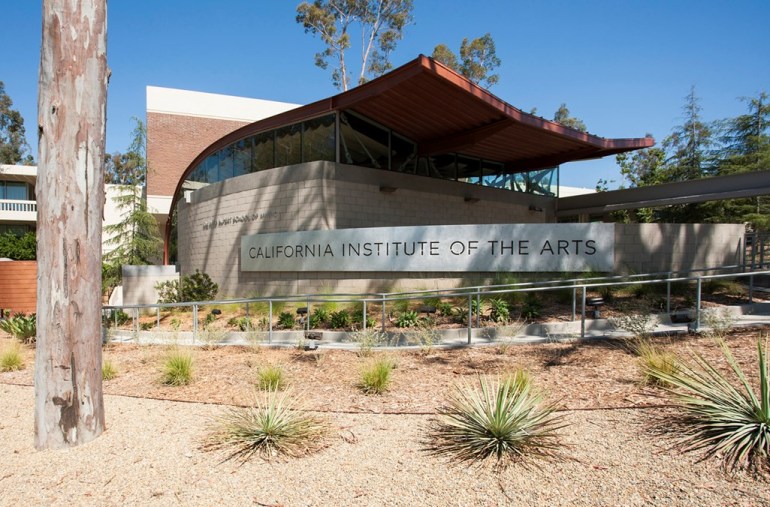
So how is it the fault of this school specifically that all the cartoon’s on Cartoon Network look the same as so many angry people on twitter say it so? Unsurprisingly Cartoon Network has a prominent production studio responsible for a significant portion of its original programming stationed in Burbank and many CalArts graduates of their Character Animation program find work there to some capacity. It’s almost like an unofficial partnership that represents a mass influx of talent that went on to shape Cartoon Network’s persona as the preeminent television animation juggernaut both in the boon period of the 1990s all the way up to the new cartoon renaissance we are presently living in. Condensed here are just a sample of the more notable and influential CalArts grads who found themselves working for Cartoon Network:
- Gendy Tartakovsky – Creator of Dexter’s Laboratory, Samurai Jack, Star Wars: The Clone Wars and Sym-Bionic Titan
- Craig McCracken – Creator of The Powerpuff Girls, Foster’s Home for Imaginary Friends
- Pendleton Ward – Creator of Adventure Time
- JG Quintel – Creator of Regular Show
- Thurup Can Orman – Creator of the Marvelous Misadventures of Flapjack
- Daniel Chong – Creator of We Bare Bears
- Skyler Page – Creator of Clarence
- Peter Browngardt – Creator of Uncle Grandpa and Secret Mountain Fort Awesome

The institute served as a talent pool for the network where these animation hopefuls frequently get lucky and capture an executive’s attention for the films they make while in the program. For example, JG Quintel’s “2 in the AMPM” which directly lead to working with the company on several shows and later became the loose basis for Regular Show. Or more recently these graduates get accepted into the Cartoon Network Shorts Department developmental program based on their merits while attending CalArts and got the opportunity to make a pilot for potential pickup, such as Daniel Chong and Skyler Page did. No one is actually denying there is a relationship between the institution and the network, but as will be demonstrated once I break down the what people mean when they say CalArts as a criticism, the influence the school’s animation program has over Cartoon Network’s content or vice versa is significantly overblown. The most I could find in terms of an actual official partnership is a scholarship sponsored by Cartoon Network for animation students, but that only came about this year and is widely insignificant to base a whole co-conspiracy charge on.

So What’s the Problem then?
So we have all these examples of animated programs that were born out of the collective collaboration of the California Institute of the Arts and their Character Animation Program with Cartoon Network’s need for new cartoons. We next have to address the second portion of the phrase; is there actually a shared style or derivative aesthetic between all these cartoons?
When people describe a cartoon as using “CalArts Style” in the current era, in a roundabout non-specific fashion they are referring to cartoons where their characters are drawn with thinner line work, rounder body shapes and less detectable detail to ensure smoother, faster animation without sacrificing the artistic quality. The rounded character models and lacking attention to detail gives characters of the supposed CalArts style an iconographic look where they remain recognizable even in silhouette, and are often completed with rudimentary shortcuts on other aspects outside of the shape. Noodle arms, nondescript dot and line mouths and eyes, stubbed hands, basic attire with few adornments or specifics, and of course eye-popping pastel colours. The result is an instantly recognizable character that can have all of its components move through space quickly and efficiently without ever losing any of the character detail. For full disclosure, this is an assembled set of qualities culled from various discussions and explainers from around the internet attempting to piece together a definitive CalArts Style because once again this is not an industry term but a fan assessment that has somehow graduated to legitimate criticism.
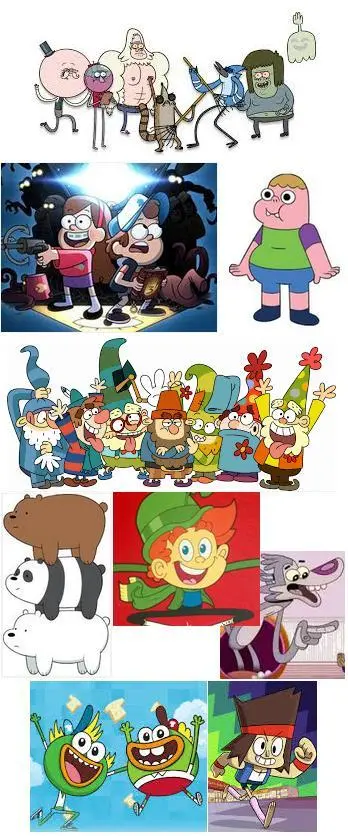
With this loose criteria for CalArts Style in mind, it becomes easy and convenient to point to the current crop of cartoons airing on television and accuse them of all being derivative. Even as I was merely listing off the visual qualities of this analogous CalArts Character Design, I am willing to bet money that Fin from Adventure Time or Steven from Steven Universe or Enid from Ok KO or Yes, even the radically altered Liono from the series announcement that sparked this whole conversation popped into your head. The description is specific yet nondescript enough to encompass so many artists personal designs that it becomes a compelling judgment for Cartoon Network’s programming. We can see little recurring elements across all these cartoons of varied settings and premises from a diverse group of university graduates, so believing in a CalArts style as the bane of all originality in animation has a very slim basis in reality outside of all the hyperbole.
Using it as a descriptor isn’t necessarily my problem with all this discourse that has erupted around a Thundercats reboot so much as all the stigma, misinformation, and misunderstanding this catchall term promotes and validates. Not to mention all the labour it commits to discrediting the talented animators working on these shows and contradict them as uninspired trend hoppers. The following image is a repeatedly invoked argument that comes up whenever a CalArts looking show is announced:

:and supposedly it represents the aesthetic singularity animation is presently trapped in. The problem here is to make this accusation accurate these armchair animation scholars have to cherry pick their examples and skew the argument to fit their impression of the style. How can you earnestly claim you are making a point when you bunch THIS set of shows together; the millennial amalgam of 2D, 3D, puppetry and stop-motion that is Amazing World of Gumball being comparable to the softened elegance and splendour of Steven Universe, or the engrossing cultish atmosphere of Gravity Falls being on the same level of the superhero royal gloss of Star Vs the The Forces of Evil. If all you have to go on is character design, then your argument that all cartoons produced nowadays are indistinguishable from one another becomes noticeably shallow and uninformed as a critique.

Which brings this to the more hot take territory when discussing this term: the look of a show is not the only thing that matters. CalArts is an aesthetic critique that encompasses the value and originality of a show based on a very surface level overview which fails to consider the writing, world building, or actual animation in its evaluation. Even if you are incapable of picking up on the visual differences (colours, atmospheric details like lights and shadow, sets, etc.) that make these shows different outside of their geometrically convergent character designs, actually watching an episode and witnessing the disparate tones and themes being addressed in these popular examples shows how inefficient a criticism it truly is. While Gumball is a comedy written like a meta, pop cultural deluge of references and jarring fourth wall experimentation, Steven Universe is characterized by a grounded sentimental core that preaches emotional intelligence through its thought-provoking characterizations and heavily dramatic story arcs. The writing staff behind these shows have worked extensively over seasons to find a unique voice to represent the series, and throwing around a YouTube buzzword to claim they are all the same discredits all the work that goes on behind the scenes before a rounded head or noodle arm is ever drawn.
When people say CalArts it does go deeper than the surface, however, as it subtly points to a supposed conspiracy of an institution that steals all the natural talent from young artists and forces them to conform to a rigid sense of aesthetics that is most marketable. Obviously when people use CalArts Style as a derision, they know what they are doing. The more accurate alternative suggestions like “Thin Line Style” or “Bean Mouth Style” cover the aesthetic sameness of what they talk about, but still frames it as a liberally chosen style to follow. CALARTS suggests indoctrination, an evil institute homogenizing art into a singularity of noodle arms and round faces, executives beating down the creative voices of eager students until they draw as we tell them to. The implications go beyond just what appears on the screen and extends to disparaging a respected institute and claiming these artists and creators have no originality, integrity and are a horde of hacks biting the most trendy style to sell their cartoons. Money over art, creativity over marketability, the respectable challenge of creating something original over the creative bankruptcy of doing whatever the network wants you to do. You attend the California Institute of the Arts, you are entered into a cult of aesthetic singularity where your integrity is beaten out of you.
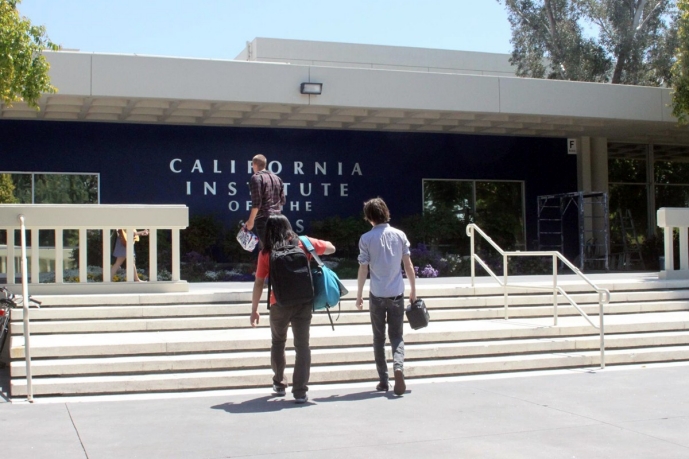
At least that is what the people who use this as a serious critique would like you to believe. In my research for this essay, I began to notice a lot of similarities between the people who claim there is a CalArts conspiracy effecting animation are the people who decry Steven Universe for being “Virtue Signalling Tumblr Garbage” and Clarence to be “SJW Pandering LGBT Propaganda.” The same people who were up in arms not only for the look of the new Thundercats reboot, were also bemoaning a bygone era when cartoons for kids could be manly, violent and promote toxic masculine toughness instead of the softness that supposedly characterizes CalArts cartoons. The backlash against any of these cartoons quickly sidesteps aesthetic evaluations and dovetails into those tired, insidious tirades against SJWs ruining entertainment and indoctrinating kids to be “self-hating feminists” or “soft around the edges” if you catch their hateful drift.
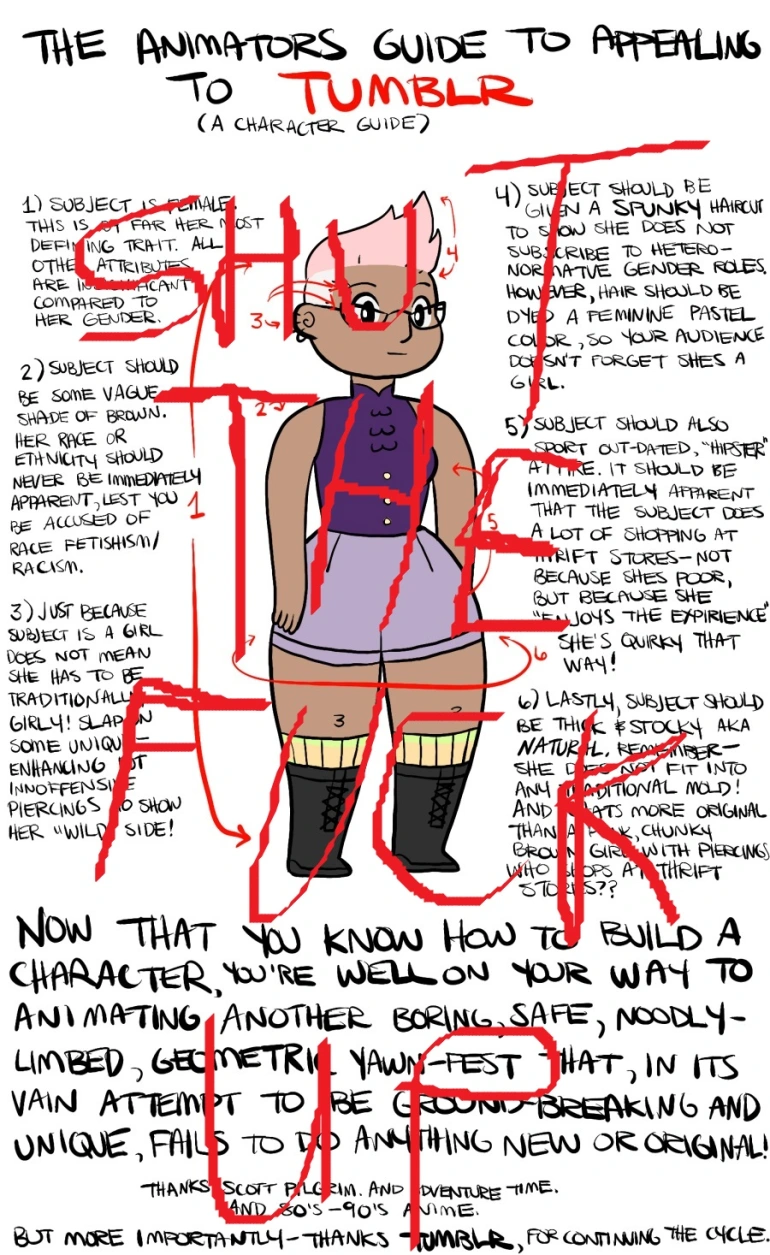
Perhaps this is all too on the nose when CalArts as a critique was popularized not only by angry Youtubers and twitter users extolling their “everything sucks” tangent for cheap outrage clicks, but also by an actual hateful monster who was only recently exposed as the predatory menace he truly is. The most notable page that comes up when you search CalArts is a blog post from 2010 by Ren and Stimpy creator and noted pedophile John Kricfalusi who goes on a bit of a tangent about how “Disney feeds on itself” by forcing its animators to simplify their designs to ease the animation process. I’m not saying we should consider who uses the scrutinized critical talking points as having bearing on their value or truthfulness, but I am kinda saying that nearly everyone who uses CalArts as a derisive argument are rarely actually mad about cartoons.

It’s funny to me how Thundercats Roar brought up all this nostalgic hearkening back to the 1980s when animation was varied and apparently bursting with individual personality when the original show when viewed through the reevaluating lens of hindsight, looks terrible nowadays. You remember the opening which because of an outsourced partnership with Studio Ghibli affiliate Topcraft looks vibrant and brimming with uncontainable hype and energy, but the rest of the show is a stiff, choppy mess of muscular models struggling to move with any fluidity. This muscular, angular model look would be carried across shows too, to other cartoons like Master of the Universe, Jem and the Holograms, GI Joe and so on. As if to say animation style perpetually lives in a cycle of artists influencing each other under set industrial conditions in certain epochs of animation history. Maybe there is a definable CalArts Style if we were to work out the specifics of what that term means, but it is ludicrous to assume this is the unfortunate apotheosis of animation style and will never change or progress beyond the thin-line, rounded style that has defined the 2010s.
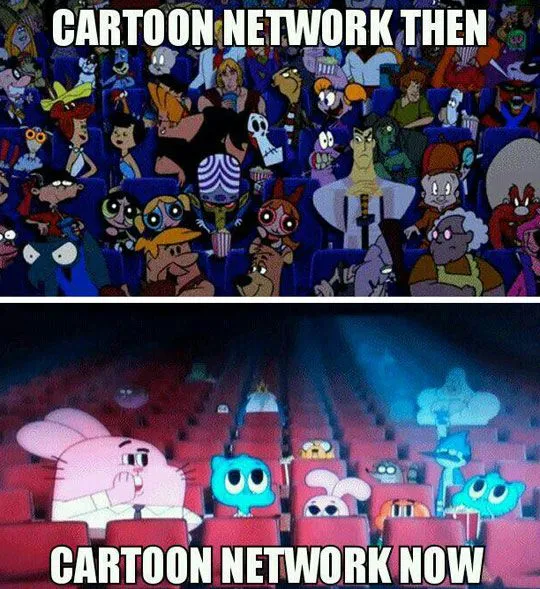
Now people tend to get really defensive when you tell them how bad CalArts is as a critique. They always default to an sidestepping accusation that by calling them out you are arguing they are not allowed to dislike the new cartoon or the style it has. Are you wrong for saying you do not like the look of the present swath of cartoons? Not at all. Hinging your defence of your critique on a buzzword, however, that has been transposed and distorted so frequently it basically means nothing does your argument no favours. Maybe you think the new Thundercats cartoon looks lazy? Fine, tell me why it looks lazy to you without invoking the nebulous label with little actual real world basis. Like, the creator of Steven Universe Rebecca Sugar didn’t even attend the god damn school you treat as a plague! If you truly want to change animation for the better, you are going to need a better argument than “CalArts = Bad Show.” Besides, personally I think every show that utilizes this style has been stellar so far, so I see no reason to have reservations about Thundercats Roar in all its globular, noodely, bean-shaped splendor.

Sources:
Cartoon Network Provides New Scholarship to CalArts Animation Students
http://johnkstuff.blogspot.com/2010/01/cal-arts-style.html
http://tvtropes.org/pmwiki/discussion.php?id=rw0l6364zts7iipuprudznqr
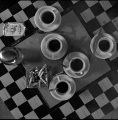

stopped reading halfway through because the image captions showed clear bias
LikeLiked by 2 people
Animators “back then” offered no romantic delusions about what it was that they were producing: 30 minute toy commercials, predominantly on a barely existent shoestring budget. Please contrast this attitude with the self-apparent disparity between Calart’s expressed goal of “empowering artists ‘to develop their own distinctive creative voices and independent points of view, and to build sturdy career pathways in line with their individual artistic aims'” and their homogenized blue-haired noodle-armed bean-mouthed pastel hell pro-LGBTQWTFBYOBBQ Commiefornian output. Or, alternatively, you could just act like a disingenuous Marxist hack and pretend to not notice any difference in the degrees of intellectual honesty expressed in animation then and animation today.
LikeLiked by 1 person
keep defending this shit art style cuck
LikeLiked by 1 person
im finna cringe. imagine defending these boring characters and lazy animation because drumpf is literally hitler and stephen universe empowers you. lmaoing @ the thought of all these generic cartoons even coming close to the quality of dexter or flapjack. hell, even the problem solverz was more based than anything being aired right now.
LikeLiked by 1 person
calarts grad detected
LikeLiked by 3 people
I can’t actually argue against any of the points you’ve made, so I’ll just post a low IQ comment instead.
LikeLiked by 2 people
thanks for the essay! super well written, hope you’re having a good day
pretty crazy how big a deal people make this. there are reasons for similarity in the animation industry right now, but from what I’ve heard a lot more of it is about making it easier to animate because studios want these things _fast_, so the animators can’t spend Hayao Miyazaki-esque amounts of time developing and creating and animating super detailed worlds. I’d love more variety (not that there’s no variety, but) since it’d be cool to see more experimental stuff. i don’t think that’s because of some fucking animator conspiracy–i think more of it is because of the expectations and pressures of being an artist under capitalism. only certain projects get funded because they’re likely to have broad appeal and merchandising opportunities.
that being said, i fucking love how creative many of these shows are even within the confines of what they’re given to work with. gravity falls will be one of my favorite shows forever!
LikeLiked by 1 person